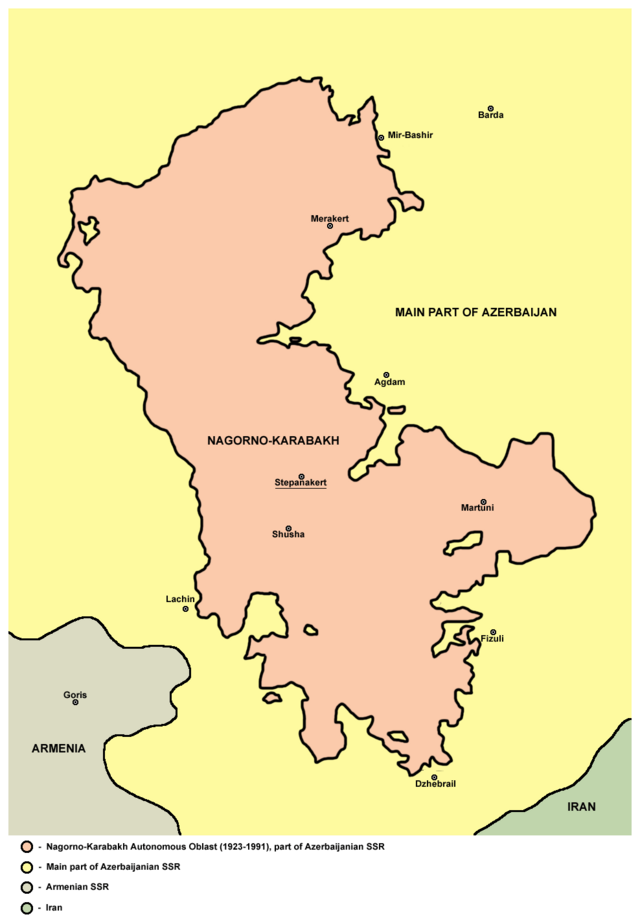Top Qs
Timeline
Chat
Perspective
Nagorno-Karabakh Autonomous Oblast
Autonomous region of the Azerbaijan SSR (1923–1991) From Wikipedia, the free encyclopedia
Remove ads
The Nagorno-Karabakh Autonomous Oblast (NKAO)[a] was an autonomous oblast within the Azerbaijan Soviet Socialist Republic that was created on July 7, 1923.[3] Its capital was the city of Stepanakert. The majority of the population were ethnic Armenians.[4]
Remove ads
History
Summarize
Perspective

The area of Nagorno-Karabakh was disputed between the First Republic of Armenia and the Azerbaijan Democratic Republic during their short-lived independence from 1918 to 1920. After the Sovietization of both republics, the Kavbiuro of the Bolshevik Party decided to keep the area within the newly-formed Azerbaijan SSR, whilst granting it broad regional autonomy.[5] Initially, the principal city of Karabakh, Shusha, and its surrounding villages were to be excluded from the autonomy as they were predominantly Azerbaijani, particularly after the massacre and expulsion of the majority Armenian population of Shusha—this decision was later reversed in 1923 when Shusha was joined to the NKAO despite protests from Muslim villages who favoured its inclusion into the Kurdistan uezd instead.[6]
On July 7, 1923, the Nagorno-Karabakh Autonomous Oblast was formally established and the capital was moved to Stepanakert, named after the revolutionary Stepan Shaumian.[4] At the time of its formation, area of the oblast was 4,161 km2 (1,607 sq mi).[7] According to the 1926 Soviet census, its population was 125,200 people, among whom Armenians accounted for 89.2 percent. However, by the 1989 census, the share of Armenians dropped to 76.9 percent of the population.[8] Reasons for this include the policy of Soviet Azerbaijani authorities to settle Azerbaijanis in the region and some out-migration of Karabakh Armenians, as well as the generally higher birthrate among Azerbaijanis than among Armenians.[9]
Although the question of Nagorno-Karabakh's status did not become a major public issue until the late 1980s, Karabakh Armenian activists, Armenian intellectuals, and Soviet Armenian leaders periodically appealed to Moscow for the oblast's transfer to the Armenian SSR. In November 1945, Armenian First Secretary Grigory Arutinov appealed to Joseph Stalin to attach the NKAO to Soviet Armenia, a proposal vetoed by Azerbaijan's Mir Jafar Baghirov.[10][11] Following Nikita Khrushchev's "Secret Speech" in 1956, Armenian Catholicos Vazgen I raised the matter of the NKAO's status in a letter to Nikolai Bulganin.[10] In 1962, Karabakh Armenian residents appealed to Khrushchev, "enumerating their grievances with official Baku and requesting the transfer of their territories from the jurisdiction of Soviet Azerbaijan to that of either Soviet Armenia or the Russian SFSR."[10] The demands from the NKAO were boosted in 1966 by an appeal signed by 1,906 Soviet Armenian intellectual and cultural figures, including Martiros Saryan, Yervand Kochar, Hamo Sahyan, and Paruyr Sevak.[10] Although their appeal was endorsed by Armenian First Secretary Anton Kochinyan and Badal Muradyan, it was vetoed by Baku, "reportedly with backstage support from Mikhail Suslov."[10]
The rise of Heydar Aliyev to the leadership of the Azerbaijani SSR in 1969 saw increasing attempts to tighten Baku's control over the autonomous oblast and alter its demographics.[9] In 1973–74, Aliyev purged the entire NKAO leadership, who Baku regarded as "Armenian nationalists." He appointed Boris Kevorkov, an Armenian from outside the NKAO, as the oblast's First Secretary.[12] In 1977, the prominent Armenian author Sero Khanzadyan wrote an open letter to Leonid Brezhnev calling for Nagorno-Karabakh's annexation to Soviet Armenia.[13][14]
Inspired by Mikhail Gorbachev's reforms of glasnost and perestroika, the Karabakh Armenians began a democratic mass movement to unite their region with the Armenian SSR. On February 20, 1988, the Supreme Soviet of the NKAO voted to unify with Soviet Armenia.[15][16] Open conflict soon broke out between the local Armenian population and the government of the Azerbaijan SSR. The fighting escalated into the First Nagorno-Karabakh War by the end of 1991. On November 26 of that year, the Supreme Soviet of Azerbaijan formally abolished the autonomous status of the oblast.[17] In response, the majority Armenian population declared their independence as the Nagorno-Karabakh Republic on December 10, with the support of Armenia.[18]
Remove ads
Administrative divisions
There were five administrative divisions or raions in the NKAO:
Demographics
First Secretaries
Summarize
Perspective
The First Secretary of the Nagorno-Karabakh Autonomous Oblast Committee of the Communist Party of Azerbaijan was the Communist Party of Azerbaijan's head and highest executive power within the oblast. The position was created in July 1923, and abolished on August 27, 1990. The position of First Secretary was de facto appointed by the Politburo of the Soviet Union or by the General Secretary of the Communist Party of the Soviet Union. Below is a list of office-holders:
Remove ads
See also
Notes
- Until 1936, Azerbaijanis were registered as Tyurki.
References
Bibliography
External links
Wikiwand - on
Seamless Wikipedia browsing. On steroids.
Remove ads

